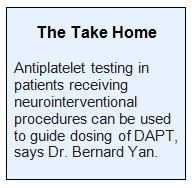Key Points:
- Researchers look for connection between platelet reactivity, hemorrhage risk in patients having neurointerventional procedures
- PRU cutoff of 175 or below identifies patients at high risk
Among patients undergoing neurointerventional procedures, a P2Y12 reaction unit (PRU) cutoff of 175 can be used to distinguish those at low or high risk of hemorrhage while on dual antiplatelet therapy (DAPT), according to research published online August 28, 2015, ahead of print in the Journal of Neurointerventional Surgery.
Investigators led by Hidehisa Nishi, MD, of Kokura Memorial Hospital (Fukuoka, Japan), evaluated whether levels of PRUs and aspirin reaction units, as measured by the VerifyNow P2Y12 assay (Accumetrics), could predict hemorrhagic complications in 279 patients who underwent carotid artery stenting, vertebral artery stenting, and coil embolization of unruptured cerebral aneurysm at their center between May 2010 and April 2013.
Patients received 100 mg/day of aspirin and 75 mg/day of clopidogrel for at least 5 days before intervention, or a loading dose of aspirin 200 mg and clopidogrel 300 mg. Procedural anticoagulation consisted of unfractionated heparin to achieve an activated clotting time of 250 to 300 seconds.
Overall, there were 31 hemorrhagic complications (11.1%) within 1 week according to International Society on Thrombosis and Hemostasis criteria. In all there were 10 intracranial hemorrhages, 9 subarachnoid hemorrhages, and 1cerebral hemorrhage. There were no cases of hemorrhagic infarction. Seventeen hemorrhages occurred at the puncture site, 3 were retroperitoneal, and 1 was hemoptysis.
Receiver-operating curve analysis revealed that PRU values predicted the risk of such complications, with a cutoff of 175 or lower indicating low risk (AUC 0.63). That threshold resulted in a sensitivity of 54%, specificity of 72%, negative predictive value of 81.0%, and positive predictive value of 19.0%. On multivariate analysis, PRU value ≤175 independently predicted increased risk for hemorrhagic complications (OR 2.61; 95% CI 1.19 to 5.72).
“Future prospective studies are required to validate whether a specific PRU value of 170–180 is predictive of hemorrhagic complications,” the researchers conclude.
Potential Place for Tailored DAPT
“There is a trade-off between ischemic and hemorrhagic complications with DAPT,” wrote Dr. Nishi in an email with WLNCMD. “Tailored antiplatelet regimens may be able to decrease both complications after neurointervention. In the future, there is some possibility that a new treatment strategy, [such as] dose adjustment of P2Y12 receptor antagonists or a change to another P2Y12 receptor antagonist in order to maintain the proper P2Y12 receptor inhibition will lower the risk of hemorrhagic complications.”
In the meantime, he said, the results require validation in another study, possibly a multicenter trial with a larger, more diverse patient population. After that, the next step might be a randomized trial comparing a fixed antiplatelet regimen with one adjusted according to PRU results.
“Establishment of an appropriate therapeutic window to avoid both ischemic and hemorrhagic complications may be required [in the clinical setting],” Dr. Nishi noted.
According to Bernard Yan, MD, of Royal Melbourne Hospital (Melbourne, Australia), the current findings validate those of his own research.
"We were the first to have found that association between hyperresponsiveness to antiplatelet agents and bleeding,” he told WLNCMD. “It’s pleasing to have another research team independent of our group confirming our findings.… We now routinely test our patients for antiplatelet responsiveness, which provides guidance towards medication adjustments according to the results."
Upon completion of their study, Dr. Yan and colleagues urgently called for larger studies to validate a clinically useful threshold to define clopidogrel hyperresponse, and he acknowledges that Dr. Nishi and colleagues have done just this in their new paper.
Source:
Nishi H, Nakahara I, Matsumoto S, et al. Platelet reactivity and hemorrhage risk in neurointerventional procedures under dual antiplatelet therapy. J NeuroIntervent Surg 2015;Epub ahead of print.
Disclosures:
- Drs. Nishi and Yan report no relevant conflicts of interest.
